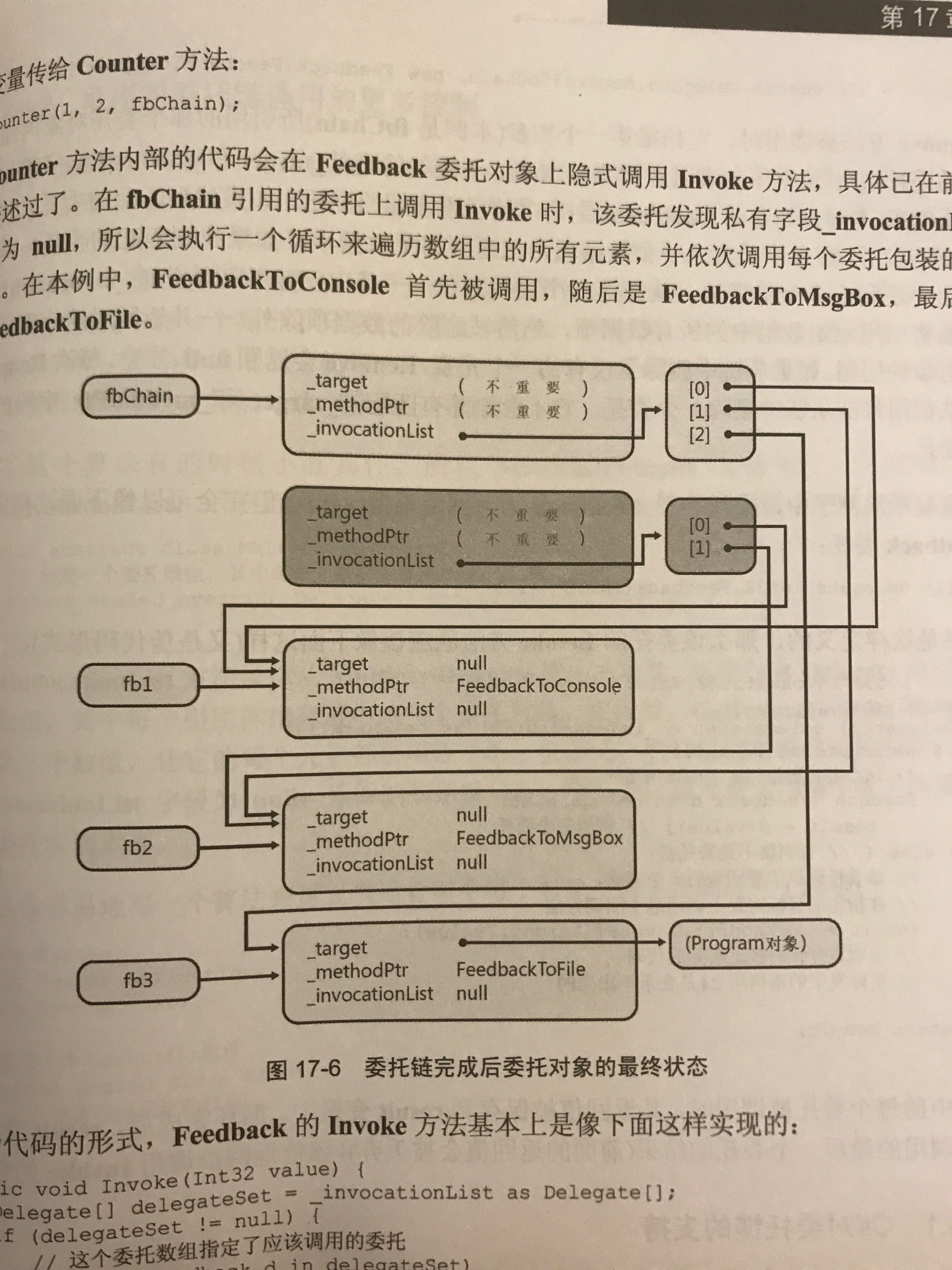前言
委托其实一直以来都感觉自己应该挺熟悉的,直到最近又去翻了翻 CLR via C#,感觉我之前的理解可能还有失偏颇。在这记录一下。
之前文章的链接:
委托(Delegate)
说起委托,我们首先应该想到 回调函数 .NET-Framework 通过委托 来提供回调函数机制。委托确保回调方法是类型安全的,委托还允许调用多个方法,并支持静态方法和实例方法。
下面通过一个具体实例来分析委托的声明,创建,以及使用。
public sealed class Program {
public static void Main() {
DelegateIntro.Go();
GetInvocationList.Go();
AnonymousMethods.Go();
DelegateReflection.Go("TwoInt32s", "Add", "123", "321");
DelegateReflection.Go("TwoInt32s", "Subtract", "123", "321");
DelegateReflection.Go("OneString", "NumChars", "Hello there");
DelegateReflection.Go("OneString", "Reverse", "Hello there");
}
}
internal sealed class DelegateIntro {
// Declare a delegate type; instances refer to a method that
// takes an Int32 parameter and returns void.
internal delegate void Feedback(Int32 value);
public static void Go() {
StaticDelegateDemo();
InstanceDelegateDemo();
ChainDelegateDemo1(new DelegateIntro());
ChainDelegateDemo2(new DelegateIntro());
}
private static void StaticDelegateDemo() {
Console.WriteLine("----- Static Delegate Demo -----");
Counter(1, 3, null);
Counter(1, 3, new Feedback(DelegateIntro.FeedbackToConsole));
Counter(1, 3, new Feedback(FeedbackToMsgBox)); // "Program." is optional
Console.WriteLine();
}
private static void InstanceDelegateDemo() {
Console.WriteLine("----- Instance Delegate Demo -----");
DelegateIntro di = new DelegateIntro();
Counter(1, 3, new Feedback(di.FeedbackToFile));
Console.WriteLine();
}
private static void ChainDelegateDemo1(DelegateIntro di) {
Console.WriteLine("----- Chain Delegate Demo 1 -----");
Feedback fb1 = new Feedback(FeedbackToConsole);
Feedback fb2 = new Feedback(FeedbackToMsgBox);
Feedback fb3 = new Feedback(di.FeedbackToFile);
Feedback fbChain = null;
fbChain = (Feedback)Delegate.Combine(fbChain, fb1);
fbChain = (Feedback)Delegate.Combine(fbChain, fb2);
fbChain = (Feedback)Delegate.Combine(fbChain, fb3);
Counter(1, 2, fbChain);
Console.WriteLine();
fbChain = (Feedback)Delegate.Remove(fbChain, new Feedback(FeedbackToMsgBox));
Counter(1, 2, fbChain);
}
private static void ChainDelegateDemo2(DelegateIntro di) {
Console.WriteLine("----- Chain Delegate Demo 2 -----");
Feedback fb1 = new Feedback(FeedbackToConsole);
Feedback fb2 = new Feedback(FeedbackToMsgBox);
Feedback fb3 = new Feedback(di.FeedbackToFile);
Feedback fbChain = null;
fbChain += fb1;
fbChain += fb2;
fbChain += fb3;
Counter(1, 2, fbChain);
Console.WriteLine();
fbChain -= new Feedback(FeedbackToMsgBox);
Counter(1, 2, fbChain);
}
private static void Counter(Int32 from, Int32 to, Feedback fb) {
for (Int32 val = from; val <= to; val++) {
// If any callbacks are specified, call them
if (fb != null)
fb(val);
}
}
private static void FeedbackToConsole(Int32 value) {
Console.WriteLine("Item=" + value);
}
private static void FeedbackToMsgBox(Int32 value) {
MessageBox.Show("Item=" + value);
}
private void FeedbackToFile(Int32 value) {
StreamWriter sw = new StreamWriter("Status", true);
sw.WriteLine("Item=" + value);
sw.Close();
}
}
在上面,Feedback 委托指定的方法接受Int32参数,返回 void。
将方法绑定到委托时,C#和CLR都允许引用类型的协变性(covariance)和逆变性(contravariance)。协变性是指方法能返回从委托的返回类型派生的一个类型。逆变性是指方法获取的参数可以是委托的参数类型的基类。关于可变性和逆变性可以参考一下之前的博文接口和委托的泛型可变性
假设定义如下委托
delegate Object MyCallback(FilStram s);
完全可以构造如下的方法:
String SomeMethod(Stream s);
SomeMethod 的返回类型(String) 派生自委托的返回类型(Object)这种协变性是允许的。SomeMethod 的参数类型(Stream)是委托的参数类型(FileStream)的基类。这种逆变性是允许的。
只有引用类型才支持协变性和逆变性,值类型或void 不支持
委托揭秘
首先让我们再来看一下这个委托的声明代码:
internal delegate void Feedback(Int32 value);
编译器会做这样一件事,把上面那段代码定义成下面这一段
internal class Feedback :System.MulticastDelegate{
//构造器
public Feedback(Object @object, Intptr method);
public virtual void Invoke(Int32 value);
public virtual IAsyncResult BeginInvoke(Int32 value, AsyncCallback callback, Object @object);
public virtual void EndInvoke(IAsyncResult result);
}
Feedback 类派生自FCL(Framework class library)定义的 System.MulticastDelegate 类
所有委托类型都派生自MulticastDelegate
委托类既可以嵌套在一个类型中定义,也可以在全局范围中定义。简单来说,由于委托是类,所以凡是能够定义类的地方,都能定义委托。
接下来介绍一下MulticastDelegate 中三个重要的非公共字段
- _target 类型为 System.Object ,当委托队形包装一个静态方法时,这个字段为null。当委托对象包装一个实例方法时,这个字段引用的是回调方法要操作的对象。换言之,这个字段指出要传给实例方法的隐式参数this 的值。
- _methodPtr 类型为 System.IntPtr 一个内部的整数值,CLR 用它来标识要回调的方法
- _invocationList 类型为 System.Object 该字段通常为 null。构造委托链时它引用一个委托数组
比如上面代码中的
Feedback fb1 = new Feedback(FeedbackToConsole)
那么这个 fb1 的状态就如下面这张图这样:

下面贴上原书中委托链的状态图(偷个懒,太难画了),

下面给出一个我本地委托测试的小Demo
Driver.cs
using System;
namespace EventDemo.CarDemo {
public class Driver {
public string Name { get; set; }
public void DriveCar () {
Console.WriteLine ($"I am driver:{Name}");
}
}
}
Passenger.cs
namespace EventDemo.CarDemo {
public class Passenger {
public string Name { get; set; }
public void BoardCar () {
System.Console.WriteLine ($"我上车了,我是:{Name}");
}
}
}
MyCar.cs
using System;
namespace EventDemo.CarDemo {
public delegate void CarHandler ();
public class MyCar {
//定义一个 上车 委托方法的事件
public event CarHandler CarNumberNotification;
public void RunCar () {
Console.WriteLine ($"好的,准备上车了!");
if (CarNumberNotification != null) {
CarNumberNotification ();
}
}
}
}
Program.cs
//纯委托版本
CarHandler carHandler = null;
carHandler += driver.DriveCar;
carHandler += passenger.BoardCar;
carHandler.Invoke();